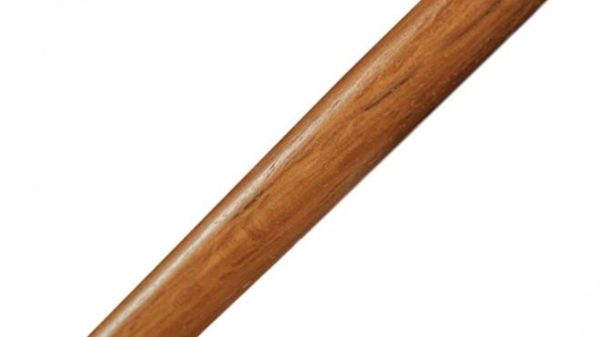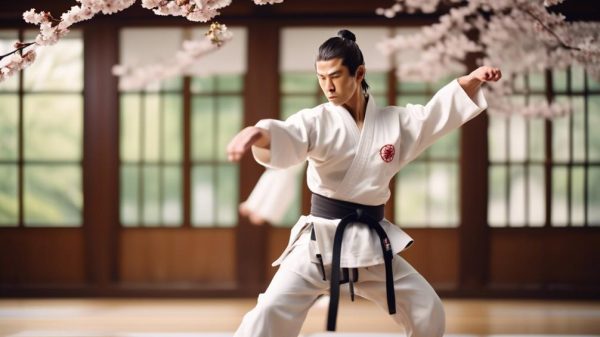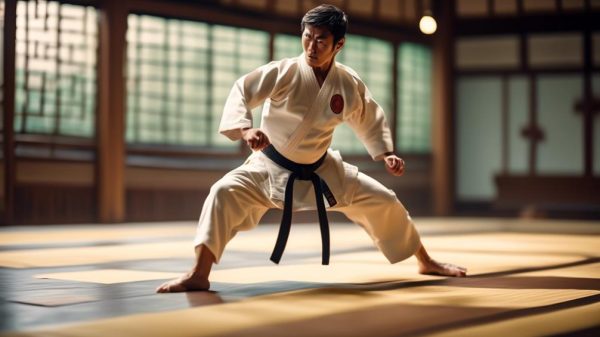The Taekwondo form called Juche highlights independent thinking and relying on oneself first rather than others. Juche means “self-reliance” which describes a big martial arts attitude.
Practicing Juche’s kicking, punching, and blocking sequences in set orders trains students to build skills their own way with personal discipline and hard work. Quick reactions get cultivated through the motions.
There are also challenging parts like stepping back in fixed stances while maneuvering all kinds of arm and leg techniques. Controlling balance stresses focus.
Angled foot shifting boosts body coordination as positions rapidly change. Students must manage stability and weight distribution while flowing nonstop.
With advanced guidance but own effort, absorbers grow in Juche persistence, sharpen mentality, and develop well-rounded physical abilities reflecting the “self-reliance” spirit.
Key Takeaways
- Juche translates as “self-reliance” and conveys relying on one’s own effort and resources rather than external forces. This independence of thought is a Taekwondo principle.
- The 45 total motions teach strategic offense, fluid reactions, and dynamic power through an array of kicking, blocking, and hand strike combinations. Versatility is developed.
- Practicing the seven step-back sequence boosts stability and control by forcing balance while in motion with low stances amid combinations for advanced practitioners.
- Angled footwork patterns advance agility, quick directional changes, maintained center of gravity, and rapid re-orientation skills. Mobility matters.
- Juche hones mental focus and discipline alongside the physical since the form demands concentrated memorization and visualizing self-defense applications. Mindset trains too.
- Proper transitional technique and breathing coordination takes precedence over congratulating athletic aptitudes that can overly tense motions. Refinement focus brings fluidity.
History of Juche Form
The concept of Juche Form replaced the Ko-Dang form in ITF-style Taekwondo due to General Choi’s strong influence from Juche Philosophy. General Choi, the founder of ITF Taekwondo, believed in the principles of self-reliance and independence, which led him to develop the Juche Form.
This form embodies the spirit of self-reliance and the Korean identity, aligning with General Choi’s philosophical beliefs. The decision to replace the Ko-Dang form with Juche Form was a strategic move to further integrate the core principles of self-reliance and independence into the practice of Taekwondo.
The historical transition from Ko-Dang to Juche Form is evident through online references and ITF literature, signifying a significant evolution in the ITF Forms. Juche Form holds great importance in ITF-style Taekwondo as it represents the fusion of martial arts with cultural and philosophical ideologies.
Its incorporation into the curriculum demonstrates the discipline’s commitment to embodying the essence of Juche Philosophy in the practice of Taekwondo.
Techniques in Juche Form
Juche Form in Taekwondo America showcases a wide range of techniques that require precision and mastery, incorporating dynamic kicks, strikes, and blocks. To excel in this form of ITF Taekwondo, it’s essential to focus on proper stances. Your stance plays a crucial role in the accuracy and power of your techniques. The form highlights the use of stances such as the Right and Left Rear Foot Stance, Sitting Stance, and Walking Stance, which serve as the foundation for executing fluid and powerful movements.
Hand techniques are also vital in Juche Form. The Middle Punch to D is a significant hand technique in this form, requiring precise execution and control. It’s important to focus on the smooth transitions and fluidity of these hand techniques to effectively complement the dynamic kicks and strikes.
One of the notable kicks in Juche Form is the High Side Piercing Kick, which demands exceptional balance, flexibility, and precision. Mastering the combination of kicks, strikes, and blocks in Juche Form requires regular practice and guidance from a qualified instructor.
Juche Form Significance
Now, let’s discuss the importance of Juche Form.
To truly grasp its significance, it’s crucial to examine its historical background, key movements within the form, and the underlying philosophy.
Historical Background of Juche
Deeply rooted in the principles of self-reliance and independence, the Juche form of Taekwondo America holds significant historical importance in the realm of ITF-style taekwondo.
The history of Juche is rich and meaningful, encompassing several key points:
- Juche form was developed by General Choi Hong Hi, the founder of ITF-style taekwondo, and it embodies the essence of self-reliance and independence.
- The form’s movements, such as the Sitting Stance, Right Rear Foot Stance, Left Reverse, and Twin Knifehand techniques, reflect the core principles of Juche philosophy.
- Juche form originated as a replacement for the Ko-Dang form, showcasing its evolution and impact within the ITF-style taekwondo community.
- The form’s connection to Lake Chon-Ji and its cultural significance in Korean history further emphasizes the historical depth and relevance of Juche form.
Key Movements in Juche
The key movements in Juche form of ITF-style taekwondo hold great historical significance. They exemplify the essence of self-reliance and independence through dynamic kicks, strikes, and blocks. This form, practiced by black belt holders in ITF Taekwondo, requires mastery of a diverse set of skills, combining hand and foot techniques with precision.
The key movements include front kicks, side kicks, punches, and palm strikes, executed with smooth transitions, proper stance, and balance. Achieving mastery in Juche requires regular practice and attention to detail. Seek guidance from a qualified instructor and utilize online resources or video tutorials to improve your techniques.
Philosophy Behind Juche
Reflecting the core principles of self-reliance and independence, the philosophy behind Juche in Taekwondo encompasses the essence of individual determination and the Korean identity.
As a black belt practitioner, understanding the significance of Juche extends beyond mastering the physical movements. It explores the deeper connection between martial arts and the spirit of self-reliance.
The Juche form’s 40 movements require mental fortitude and physical precision, serving as a testament to the philosophy’s focus on self-discipline and determination. Incorporating a jumping split-kick and mid-air pauses, it challenges practitioners to exceed their limits and embrace the essence of Juche.
Developed by General Choi, the founder of ITF-style Taekwondo, this form is deeply rooted in the principles of Juche philosophy and plays a crucial role in the practitioner’s journey to mastery.
Juche Form in Taekwondo America
Let’s discuss the important aspects to consider when practicing Juche Form in Taekwondo America.
This form requires precise execution of dynamic kicks, strikes, and blocks, along with a strong focus on technique.
As you explore the overview and techniques of Juche Form, you’ll discover its intricate details that make it a vital part of advanced Taekwondo training.
Juche Form Overview
The Juche Form in Taekwondo America is a highly advanced form that embodies the essence of Taekwondo practice. It requires precision, fluidity, and a deep understanding of the philosophy it represents.
This form is specifically designed for 3rd-degree black belt practitioners in Taekwondo America, serving as a test of their advanced skills and techniques. It incorporates dynamic kicks, strikes, and blocks, with a focus on smooth transitions between movements. To become a master of this form, regular practice is essential, as well as paying attention to details and seeking guidance from a qualified instructor.
It’s also beneficial to visualize how each movement can be applied in a self-defense scenario. Taekwondo America offers a range of forms and patterns for practitioners at different levels, and watching videos of experienced practitioners performing various forms can be a valuable learning tool.
The Juche form is closely connected to the ideology of North Korea, reflecting the principles of Juche philosophy, which emphasizes self-reliance and independence.
Juche Form Techniques
The Juche Form in Taekwondo America focuses on mastering dynamic kicks, strikes, and blocks with smooth transitions between movements. It’s a testament to the advanced skills and techniques of 3rd-degree black belt practitioners.
Paying attention to detail is essential to excel in this form. Seek guidance from an instructor, visualize the practical application of each movement in self-defense, and practice regularly.
Form Juche not only improves physical abilities but also enhances mental focus, self-discipline, and self-confidence.
Watching videos of experienced practitioners performing different forms on platforms like the ITF website and YouTube can be a valuable learning tool.
Approach this process with passion and precision to elevate your Taekwondo skills.
Juche Form Training Tips
To improve your skills in the Juche form of Taekwondo America, focus on regular practice to develop muscle memory and refine your technique. Here are some tips to help you enhance your performance:
- Pay close attention to details such as hand positioning and footwork to ensure precision in each movement.
- Break down the form into smaller sections and practice each section individually. This will allow you to focus on specific areas that may need improvement.
- Seek guidance and feedback from a qualified Taekwondo instructor. Their expertise can provide valuable insights and corrections to improve your execution of the form.
- Imagine how each movement can be applied in a self-defense situation to understand the practical significance of the form’s techniques.
Juche Form Performance
In order to excel in the Juche form of Taekwondo America, focus on incorporating smooth and precise kicks, strikes, and blocks, with seamless transitions between movements. Highlight the dynamic nature of this form, demonstrating both power and grace in each technique.
To enhance your mastery of the Juche form, refer to the following video guidelines and resources:
- Left Formation: Maintain balance and focus on technique, ensuring fluid transitions and controlled power.
- Right Formation: Similarly, maintain balance and focus on technique, with an emphasis on fluid transitions and controlled power.
Juche Form Belt Requirements
Mastering the Juche Form in Taekwondo America requires understanding the essential belt requirements. These requirements are crucial for advancing in your martial arts journey. Here are the key elements to focus on:
- Dedication: To achieve mastery, you must be dedicated to consistent practice and improvement.
- Attention to Detail: Pay close attention to the precise execution of each movement to master this intricate form.
- Guidance from Experts: Seek guidance from a qualified Taekwondo instructor who’s in-depth knowledge of the Juche Form. Their insights will be invaluable to your progress.
- Visualization: Visualize the practical application of each technique in self-defense scenarios. This will deepen your understanding of the form’s purpose and significance.
As you progress through the belt levels, the expectations for mastering the Juche Form will increase. It’s important to immerse yourself in the rich history and philosophy behind this form. It’s deeply connected to the Korean identity and emphasizes principles such as self-reliance, independence, and mental discipline.
Juche Form Practice Benefits
Practicing Form Juche in Taekwondo America offers numerous benefits for individuals looking to improve their physical and mental abilities.
This ITF Taekwondo form incorporates dynamic movements, such as jumping motions, and powerful techniques like the High Outward Guarding Block. By mastering this form, practitioners can develop strength, flexibility, and mental focus.
Precisely executing movements like forming a Left Rear and maintaining a Posture of Parallel Stance not only improves physical fitness and coordination but also promotes self-discipline and self-confidence.
Moreover, the emphasis on techniques like the Left Knifehand encourages practitioners to refine their skills and demonstrate mastery of Taekwondo techniques.
Form Juche serves as a foundation for further progress in Taekwondo training, providing practitioners with a solid base to build upon.
Through dedicated practice and attention to detail, individuals can unlock the many benefits that Form Juche offers, ultimately propelling them towards mastery in the art of Taekwondo.
Juche Form Variations
Juche Form Variations highlight the dynamic kicks, strikes, and blocks that enhance strength, flexibility, and mental focus developed through practicing Form Juche in Taekwondo America.
When exploring Juche Form Variations, consider the following aspects:
- Influence of ITF Taekwondo: Juche Form is based on ITF/Chang Hon-style Taekwondo, reflecting Choi Hong Hi’s Tae Kwon Do.
- Online References: Use online resources to deepen your understanding of the intricacies and nuances of Juche Form Variations.
- Video Selection: Choose a video that effectively demonstrates Juche Form Variations, ensuring it aligns with CC-BY-SA guidelines.
- School Instruction: Some schools may teach Juche Form Variations, offering different perspectives and interpretations to learn from.
Frequently Asked Questions
What Is the Meaning of Juche in Taekwondo?
Mastering Juche in Taekwondo involves understanding and embodying the principles of self-reliance and independence. It encompasses the practice of the Juche stance, utilizing specialized breathing techniques, and incorporating visualizations of Juche symbolism to enhance one’s self-defense skills and martial arts abilities. By embracing these concepts, practitioners can develop a strong foundation and improve their overall performance in Taekwondo.
How Do You Memorize Taekwondo Forms?
To memorize Taekwondo forms, you can use visual aids and repetition techniques. Break down the movements and create mental associations to help you remember. It’s important to practice regularly in order to build muscle memory. Seek out group practice sessions, take written notes, and watch video tutorials to enhance your learning and achieve mastery.
Why Are There 24 Patterns in Taekwondo?
The 24 patterns in Taekwondo hold great significance as they represent the historical evolution, technical complexity, mental discipline, and symbolic representation of the martial art. These patterns play a vital role in the progression of training and carry cultural importance. They also showcase international variations, reflecting the global impact of Taekwondo.
How Many Taekwondo Patterns Are There?
There are 24 patterns in Taekwondo, which are important for advancing through the belt ranks and hold historical significance. While there may be some variations between regions, these patterns help develop mental focus, practical self-defense skills, and uphold traditional values. They have also been adapted for modern use in discipline mastery and competitive settings.









